Investigating the Effects of Super Typhoon HAGIBIS in the Northwest Pacific Ocean Using Multiple Observational Data
Abstract
1. Introduction
- Is it possible to interpret the changes in daily ocean variables in response to typhoon HAGIBIS under the KCM?
- Which typhoon factor is responsible for physical and biological ocean responses such as ST, SS, MLD, and PB on the sea surface?
- Is it possible to distinguish the favorable environment of the PB and interpret the cause of the widespread occurrence of a PB using a comprehensive impact analysis before and after a typhoon?
2. Materials and Methods
2.1. Target Event and Region
Super Typhoon HAGIBIS and the Study Area

2.2. Multi-Source Observational and Model Data
2.2.1. Ocean Wind Product Data and Estimated Typhoon Effects
- Wind speed and wind stress data
- Equations
2.2.2. Surface Ocean Variables
- SST, SSS, and MLD
- Chl-a
- SLA and GV
- Daily cumulative precipitation
2.2.3. Vertical Profile of Subsurface Ocean Variables
2.3. Methodology
- [Step 1] The typhoon effects on the NPO were estimated in terms of and EPV. Firstly, six-hourly wind speed data was validated by JMA data (1.1). The visualized spatial distribution shows the magnitude, direction, and impacted area of strong and high EPV every six hours (1.2).
- [Step 2] To interpret the physical KCM features such as meander and eddies, we reproduced the KCM expressed by SLA and GV and validated the KCM by another trajectory data analyzed by JCC (2.1). Further, the spatial distribution of SLA and GV detected the area of existing cyclonic and anticyclonic eddies (2.2). Then, we estimated the vertical variability of KCM based on 0, 60, and 100 m depths during HAGIBIS.
- [Step 3] We explored the response of ocean variables near the sea surface, considering SST, SSS, MLD, and Chl-a as well as daily cumulative rainfall. This was conducted to validate the global CMEMS model data in the study area through in situ data (3.1). The changes in surface variables (SST, SSS, Chl-a) can be estimated by where, when, and to what extent the typhoon affects the study area (3.2). The following work was used through the MLD and daily precipitation to evaluate other significant evidence (3.3).
- [Step 4] To interpret the sea surface PB one day after HAGIBIS, this study was expanded using vertical profiles showing the subsurface ocean variabilities according to a specific depth. These findings were conducted largely in two parts. Firstly, it was evaluated as a favorable environmental condition for PB growth via Argo float data (4.1). Secondly, the overall estimated spatial distribution was presented in a quantitative conceptual diagram using a comprehensive impact analysis to identify the biological growth process of the PB in the upper ocean (4.2).
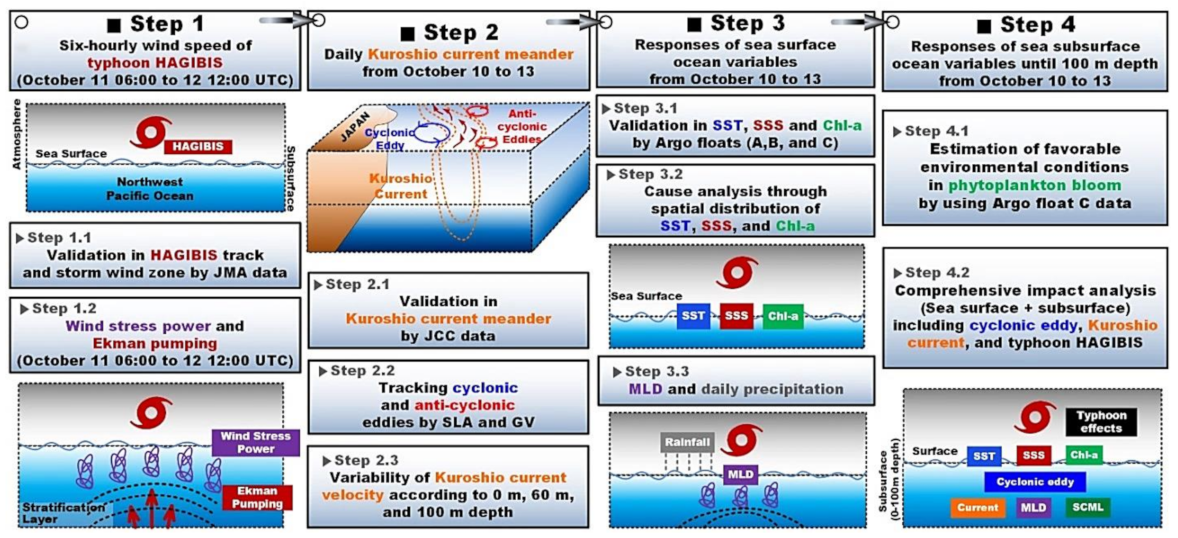
3. Results
3.1. Wind Effects Induced by HAGIBIS
3.1.1. Validation of CMEMS Model Data by Comparison with JMA
3.1.2. Wind Stress Power () and Ekman Pumping Velocity (EPV)
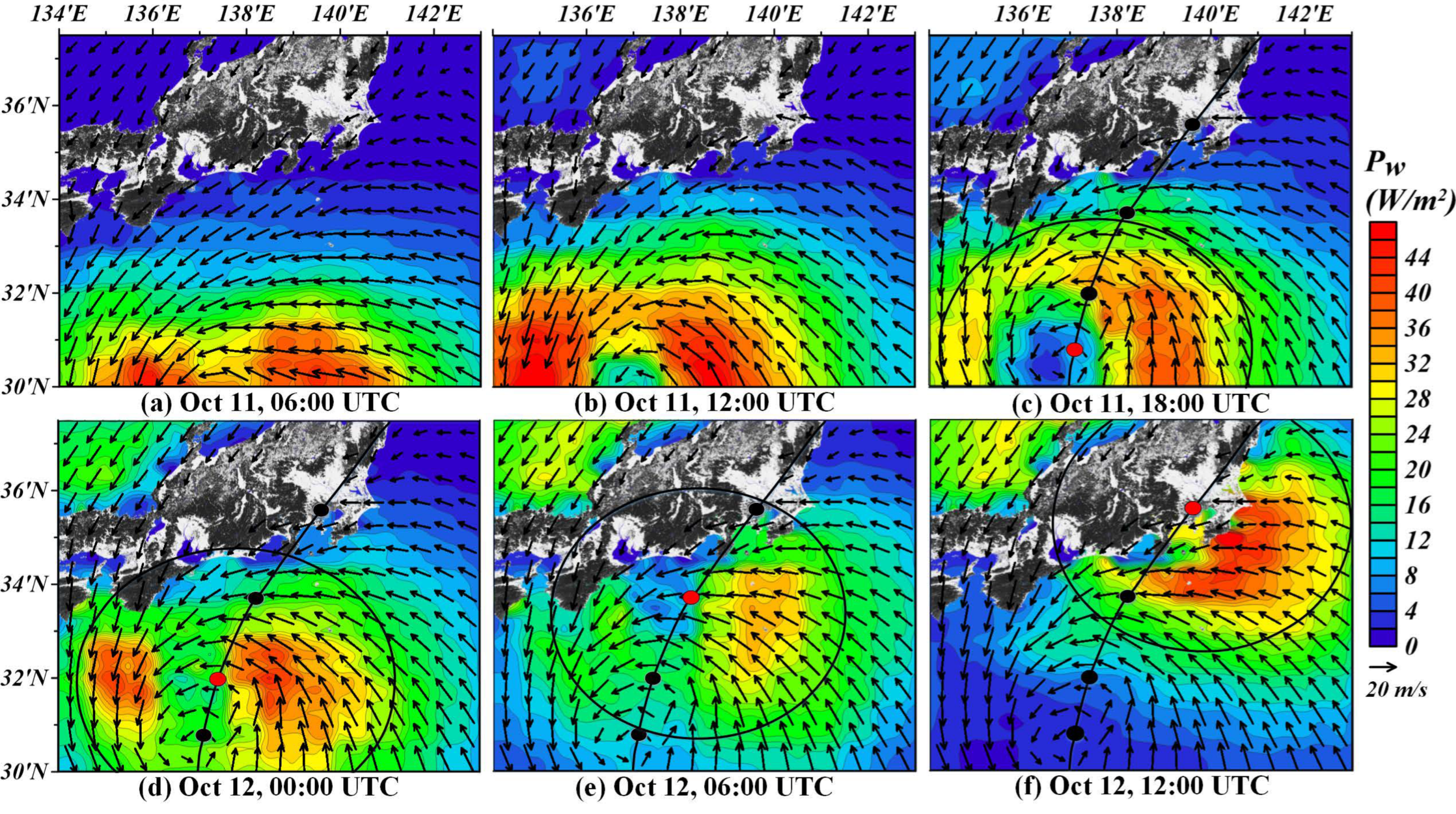
3.2. Environmental Condition in the NPO
3.2.1. Validation of the KCM and Tracking Cyclonic and Anticyclonic Eddies
3.2.2. Variability of the KCM According to 0, 60, and 100 m Depth

3.3. Responses of Sea Surface Ocean Variables
3.3.1. Validation of SST, SSS, and Chl-a by In-Situ Data
| Factor | Argo Floats | Latitude(°N) | Longitude(°E) | Date | In-Situ Value | CMEMS Value |
|---|---|---|---|---|---|---|
| SST (°C) | A * 2903367 | 30.504 | 135.767 | 10 October | 28.00 | 27.89 (−0.11) |
| B * 2902754 | 33.580 | 138.607 | 9 October | 26.47 | 26.41 (−0.06) | |
| C1 * 2903376 | 33.716 | 137.403 | 9 October | 26.17 | 26.06 (−0.11) | |
| SSS (psu) | A 2903367 | 30.504 | 135.767 | 10 October | 34.52 | 34.46 (−0.06) |
| B 2902754 | 33.580 | 138.607 | 9 October | 33.95 | 34.01 (+0.06) | |
| C1 2903376 | 33.716 | 137.403 | 9 October | 34.02 | 34.01 (−0.01) | |
| Chl-a () | C1 2903376 | 33.716 | 137.403 | 9 October | 0.30 | 0.35 (+0.05) |
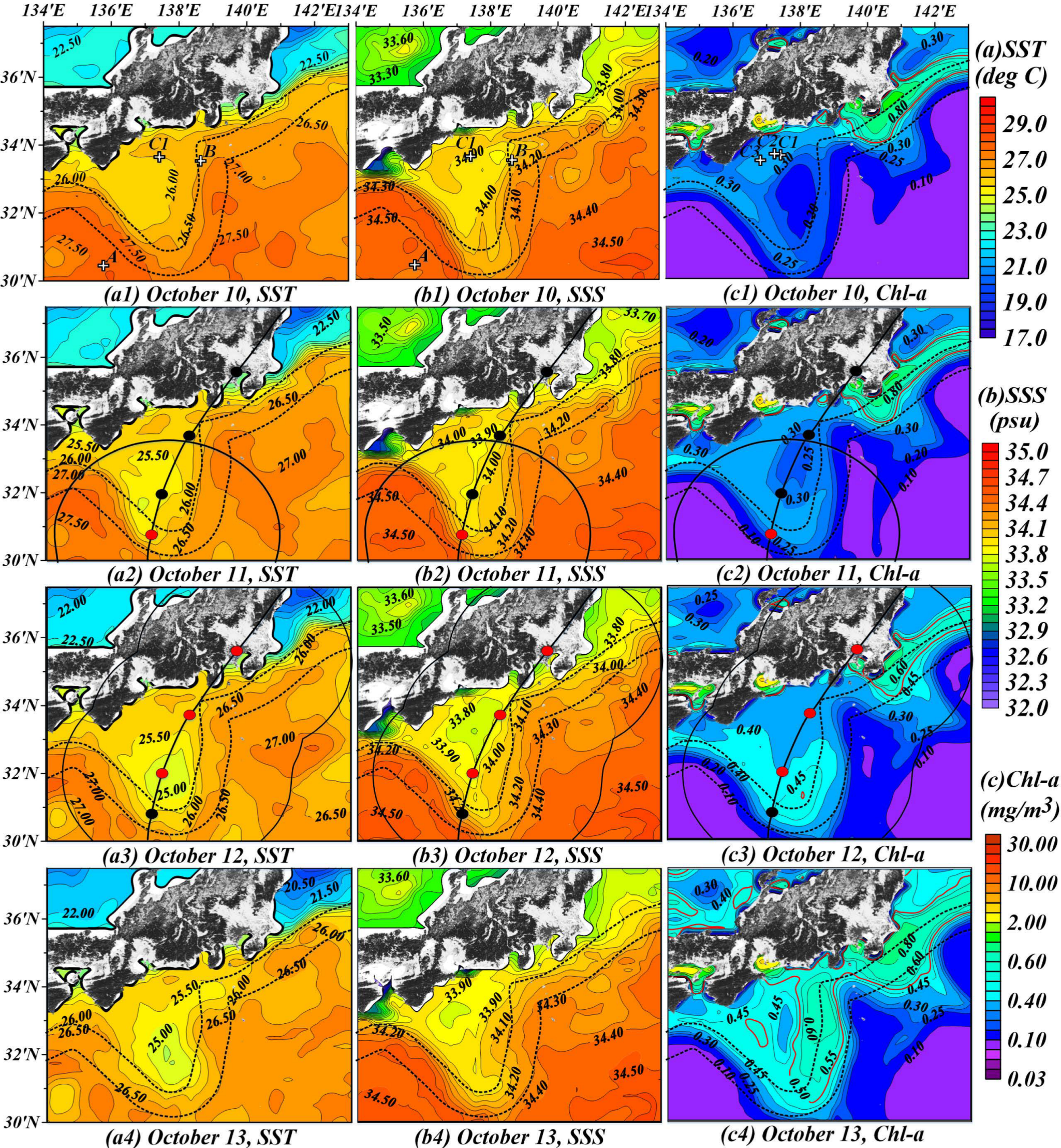
3.3.2. Cause Analysis through Spatial Distribution of SST, SSS, and Chl-a
3.3.3. MLD and Daily Precipitation
3.4. Responses of Sea Subsurface Ocean Variables until 100 m Depth
3.4.1. Favorable Environmental Conditions in Phytoplankton Bloom
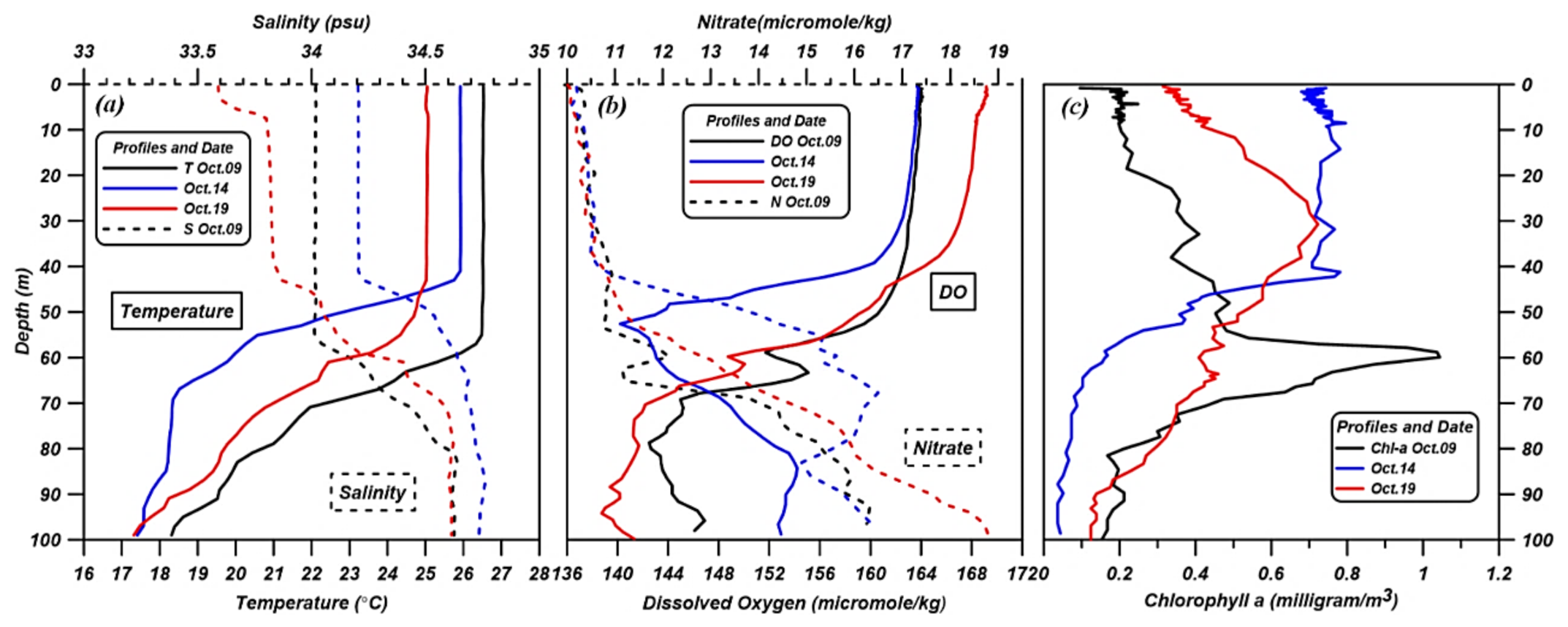
3.4.2. Comprehensive Impact Analysis
4. Conclusions
Author Contributions
Funding
Acknowledgments
Conflicts of Interest
References
- Chan, J.C.L. Interannual and Interdecadal Variations of Tropical Cyclone Activity over the Western North Pacific. Meteorol. Atmos. Phys. 2005, 89, 143–152. [Google Scholar] [CrossRef]
- Zhang, H.; He, H.; Zhang, W.Z.; Tian, D. Upper Ocean Response to Tropical Cyclones: A Review. Geosci. Lett. 2021, 8, 1–12. [Google Scholar] [CrossRef]
- Price, J.F.; Sanford, T.B.; Forristall, G.Z. Forced Stage Response to a Moving Hurricane. J. Phys. Oceanogr. 1994, 24, 233–260. [Google Scholar] [CrossRef]
- Wang, W.; Huang, R.X. Wind Energy Input to the Ekman Layer. J. Phys. Oceanogr. 2004, 34, 1267–1275. [Google Scholar] [CrossRef]
- Liu, L.L.; Wang, W.; Huang, R.X. The Mechanical Energy Input to the Ocean Induced by Tropical Cyclones. J. Phys. Oceanogr. 2008, 38, 1253–1266. [Google Scholar] [CrossRef]
- Jullien, S.; Menkes, C.E.; Marchesiello, P.; Jourdain, N.C.; Lengaigne, M.; Koch-larrouy, A.; Lefé vre, J.; Vincent, E.M.; Faure, V. Impact of Tropical Cyclones on the Heat Budget of the South Pacific Ocean. J. Phys. Oceanogr. 2012, 42, 1882–1906. [Google Scholar] [CrossRef]
- Lin, I.-I.; Liu, W.T.; Wu, C.C.; Chiang, J.C.H.; Sui, C.H. Satellite Observations of Modulation of Surface Winds by Typhoon-Induced Upper Ocean Cooling. Geophys. Res. Lett. 2003, 30, 6–9. [Google Scholar] [CrossRef]
- Zhang, H.; Chen, D.; Zhou, L.; Liu, X.; Ding, T.; Zhou, B. Upper Ocean Response to Typhoon Kalmaegi (2014). J. Geophys. Res. Ocean. 2016, 121, 6520–6535. [Google Scholar] [CrossRef]
- Yue, X.; Zhang, B.; Liu, G.; Li, X.; Zhang, H.; He, Y. Upper Ocean Response to Typhoon Kalmaegi and Sarika in the South China Sea from Multiple-Satellite Observations and Numerical Simulations. Remote Sens. 2018, 10, 348. [Google Scholar] [CrossRef]
- Lin, I.-I. Typhoon-Induced Phytoplankton Blooms and Primary Productivity Increase in the Western North Pacific Subtropical Ocean. J. Geophys. Res. Ocean. 2012, 117, C03039. [Google Scholar] [CrossRef]
- Zhang, H.; Liu, X.; Wu, R.; Chen, D.; Zhang, D.; Shang, X.; Wang, Y.; Song, X.; Jin, W.; Yu, L.; et al. Sea Surface Current Response Patterns to Tropical Cyclones. J. Mar. Syst. 2020, 208, 103345. [Google Scholar] [CrossRef]
- Zhang, H.; Liu, X.; Wu, R.; Liu, F.; Yu, L.; Shang, X.; Qi, Y.; Wang, Y.; Song, X.; Xie, X.; et al. Ocean Response to Successive Typhoons Sarika and Haima (2016) Based on Data Acquired via Multiple Satellites and Moored Array. Remote Sens. 2019, 11, 2360. [Google Scholar] [CrossRef]
- Girishkumar, M.S.; Suprit, K.; Chiranjivi, J.; Udaya Bhaskar, T.V.S.; Ravichandran, M.; Shesu, R.V.; Pattabhi Rama Rao, E. Observed Oceanic Response to Tropical Cyclone Jal from a Moored Buoy in the South-Western Bay of Bengal. Ocean Dyn. 2014, 64, 325–335. [Google Scholar] [CrossRef]
- Cullen, J.J. Subsurface Chlorophyll Maximum Layers: Enduring Enigma or Mystery Solved? Ann. Rev. Mar. Sci. 2015, 7, 207–239. [Google Scholar] [CrossRef] [PubMed]
- Huisman, J.; Pham Thi, N.N.; Karl, D.M.; Sommeijer, B. Reduced Mixing Generates Oscillations and Chaos in the Oceanic Deep Chlorophyll Maximum. Nature 2006, 439, 322–325. [Google Scholar] [CrossRef]
- Wang, Z.; Goodman, L. The Evolution of a Thin Phytoplankton Layer in Strong Turbulence. Cont. Shelf Res. 2010, 30, 104–118. [Google Scholar] [CrossRef]
- Sugimoto, S.; Qiu, B.; Kojima, A. Marked Coastal Warming off Tokai Attributable to Kuroshio Large Meander. J. Oceanogr. 2020, 76, 141–154. [Google Scholar] [CrossRef]
- Qiu, B.; Chen, S.; Schneider, N.; Oka, E.; Sugimoto, S. On the Reset of the Wind-Forced Decadal Kuroshio Extension Variability in Late 2017. J. Clim. 2021, 33, 10813–10828. [Google Scholar] [CrossRef]
- Morioka, Y.; Varlamov, S.; Miyazawa, Y. Role of Kuroshio Current in Fish Resource Variability off Southwest Japan. Sci. Rep. 2019, 9, 17942. [Google Scholar] [CrossRef]
- Sugimoto, S.; Qiu, B.; Schneider, N. Local Atmospheric Response to the Kuroshio Large Meander Path in Summer and Its Remote Influence on the Climate of Japan. J. Clim. 2021, 34, 3571–3589. [Google Scholar] [CrossRef]
- Steinberg, D.K.; Carlson, C.A.; Bates, N.R.; Johnson, R.J.; Michaels, A.F.; Knap, A.H. Overview of the US JGOFS Bermuda Atlantic Time-Series Study (BATS): A Decade-Scale Look at Ocean Biology and Biogeochemistry. Deep. Res. Part II Top. Stud. Oceanogr. 2001, 48, 1405–1447. [Google Scholar] [CrossRef]
- Groom, S.B.; Sathyendranath, S.; Ban, Y.; Bernard, S.; Brewin, B.; Brotas, V.; Brockmann, C.; Chauhan, P.; Choi, J.K.; Chuprin, A.; et al. Satellite Ocean Colour: Current Status and Future Perspective. Front. Mar. Sci. 2019, 6, 00485. [Google Scholar] [CrossRef]
- Chai, F.; Johnson, K.S.; Claustre, H.; Xing, X.; Wang, Y.; Boss, E.; Riser, S.; Fennel, K.; Schofield, O.; Sutton, A. Monitoring Ocean Biogeochemistry with Autonomous Platforms. Nat. Rev. Earth Environ. 2020, 1, 315–326. [Google Scholar] [CrossRef]
- Li, M.; Yuan, Y.; Wang, N.; Li, Z.; Li, Y.; Huo, X. Estimation and Analysis of Galileo Differential Code Biases. J. Geod. 2017, 91, 279–293. [Google Scholar] [CrossRef]
- Banzon, V.; Smith, T.M.; Mike Chin, T.; Liu, C.; Hankins, W. A Long-Term Record of Blended Satellite and in Situ Sea-Surface Temperature for Climate Monitoring, Modeling and Environmental Studies. Earth Syst. Sci. Data 2016, 8, 165–176. [Google Scholar] [CrossRef]
- Le Traon, P.Y.; Reppucci, A.; Fanjul, E.A.; Aouf, L.; Behrens, A.; Belmonte, M.; Bentamy, A.; Bertino, L.; Brando, V.E.; Kreiner, M.B.; et al. From Observation to Information and Users: The Copernicus Marine Service Perspective. Front. Mar. Sci. 2019, 6, 00234. [Google Scholar] [CrossRef]
- Pan, J.; Huang, L.; Devlin, A.T.; Lin, H. Quantification of Typhoon-Induced Phytoplankton Blooms Using Satellite Multi-Sensor Data. Remote Sens. 2018, 10, 318. [Google Scholar] [CrossRef]
- Kara, A.B.; Rochford, P.A.; Hurlburt, H.E. An Optimal Definition for Ocean Mixed Layer Depth. J. Geophys. Res. Ocean. 2000, 105, 16803–16821. [Google Scholar] [CrossRef]
- Bessho, K.; Date, K.; Hayashi, M.; Ikeda, A.; Imai, T.; Inoue, H.; Kumagai, Y.; Miyakawa, T.; Murata, H.; Ohno, T.; et al. An Introduction to Himawari-8/9—Japan’s New-Generation Geostationary Meteorological Satellites. J. Meteorol. Soc. Jpn. 2016, 94, 151–183. [Google Scholar] [CrossRef]
- Bentamy, A.; Grodsky, S.A.; Cambon, G.; Tandeo, P.; Capet, X.; Roy, C.; Herbette, S.; Grouazel, A. Twenty-Seven Years of Scatterometer Surface Wind Analysis over Eastern Boundary Upwelling Systems. Remote Sens. 2021, 13, 940. [Google Scholar] [CrossRef]
- Sun, L.; Li, Y.X.; Yang, Y.J.; Wu, Q.; Chen, X.T.; Li, Q.Y.; Li, Y.B.; Xian, T. Effects of Super Typhoons on Cyclonic Ocean Eddies in the Western North Pacific: A Satellite Data-Based Evaluation between 2000 and 2008. J. Geophys. Res. Ocean. 2014, 119, 5585–5598. [Google Scholar] [CrossRef]
- Liu, X.; Wei, J. Understanding Surface and Subsurface Temperature Changes Induced by Tropical Cyclones in the Kuroshio. Ocean Dyn. 2015, 65, 1017–1027. [Google Scholar] [CrossRef]
- Chen, J.; Jiang, C.; Wu, Z.; Long, Y.; Deng, B.; Liu, X. Numerical Investigation of Fresh and Saltwater Distribution in the Pearl River Estuary during a Typhoon Using a Fully Coupled Atmosphere-Wave-Ocean Model. Water 2019, 11, 646. [Google Scholar] [CrossRef]
- Wang, T.; Chen, F.; Zhang, S.; Pan, J.; Devlin, A.T.; Ning, H.; Zeng, W. Physical and Biochemical Responses to Sequential Tropical Cyclones in the Arabian Sea. Remote Sens. 2022, 14, 529. [Google Scholar] [CrossRef]
- Lizarbe Barreto, D.A.; Chevarria Saravia, R.; Nagai, T.; Hirata, T. Phytoplankton Increase Along the Kuroshio Due to the Large Meander. Front. Mar. Sci. 2021, 8, 677632. [Google Scholar] [CrossRef]
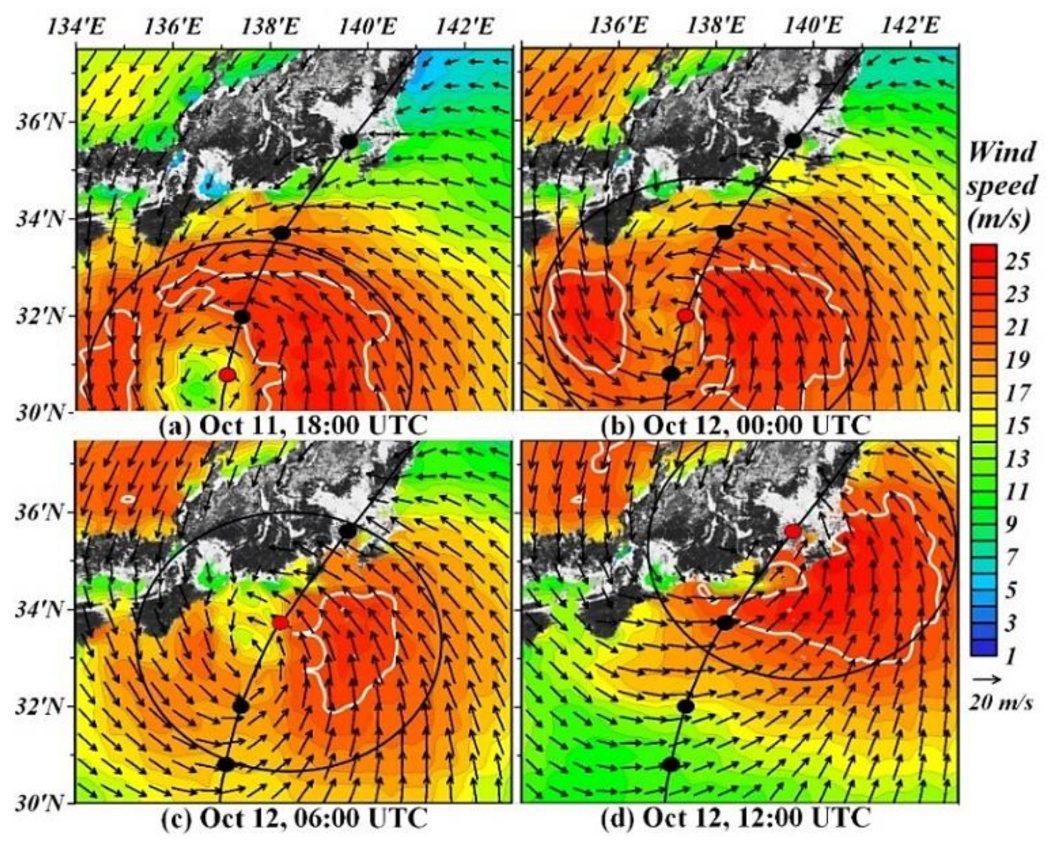
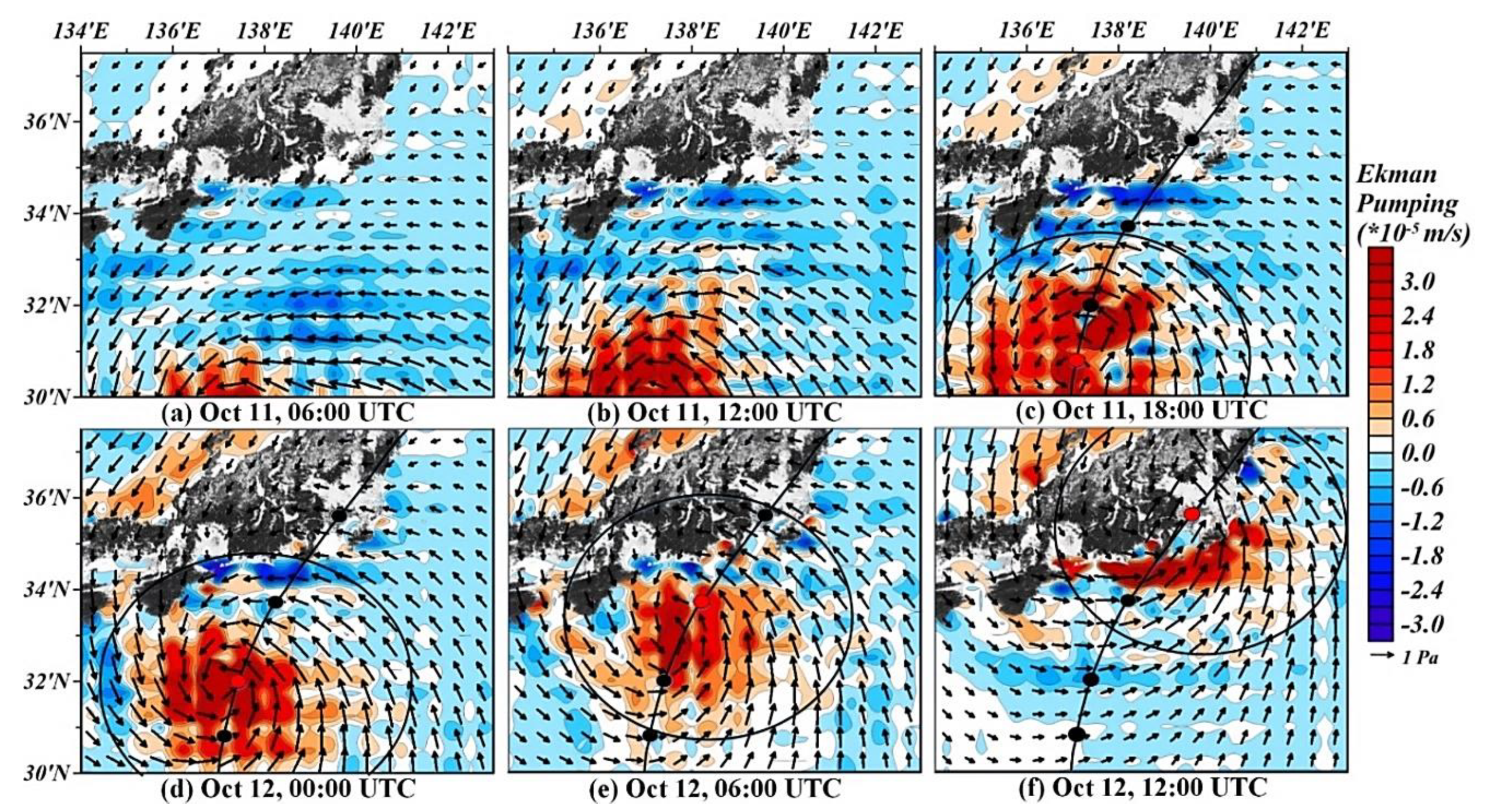
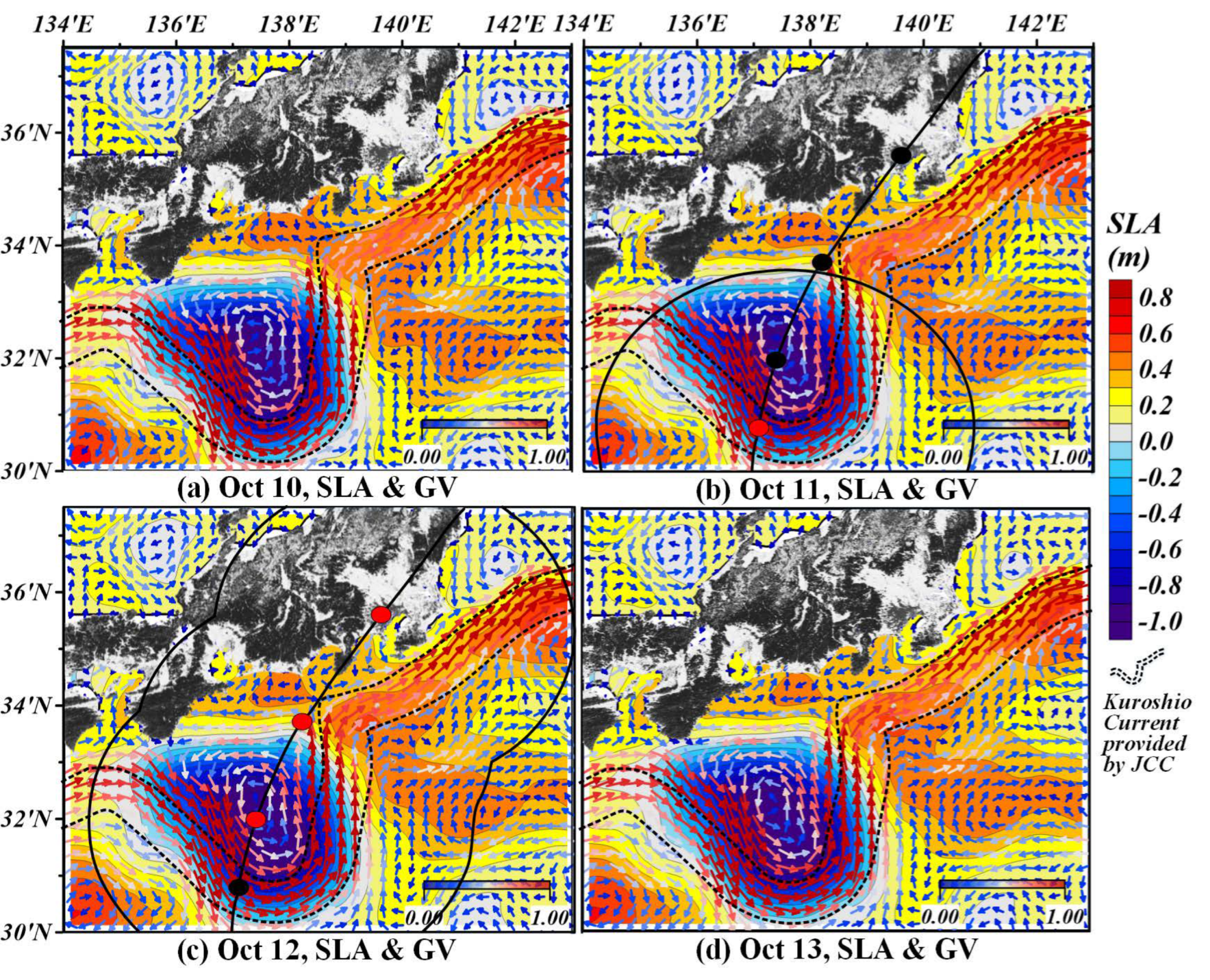
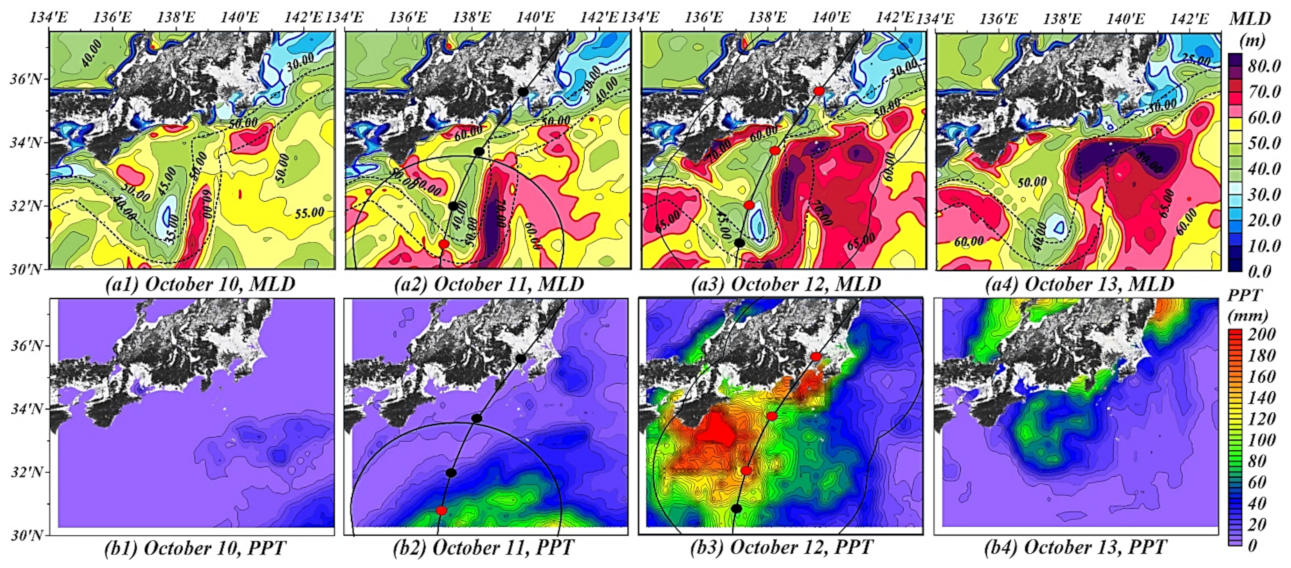
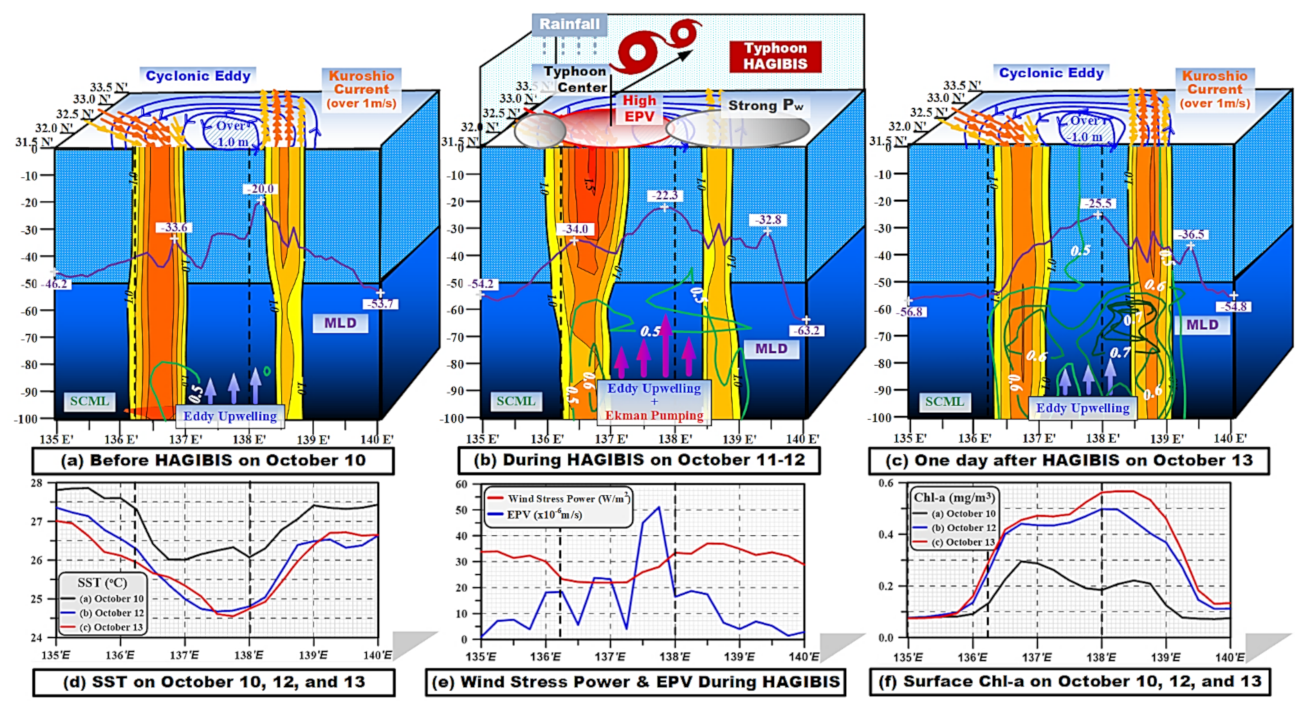
| Platform Code | Available Date | Parameters | Source |
| Physical 2903367 | 28 May 2019 to 20 July 2020 | Sea pressure, temperature, and practical salinity | ftp://nrt.cmems-du.eu/Core/INSITU_GLO_NRT_OBSERVATIONS_013_030/glo_multiparameter_nrt/monthly/PF/201910/GL_PR_PF_2903376_201910.nc (accessed on 31 May 2022) |
| Physical 2903376 | 3 August 2019 to 1 October 2020 | Sea pressure, temperature, and practical salinity | ftp://nrt.cmems-du.eu/Core/INSITU_GLO_NRT_OBSERVATIONS_013_030/glo_multiparameter_nrt/monthly/PF/201910/GL_PR_PF_2903367_201910.nc (accessed on 31 May 2022) |
| BGC 2902754 | 30 August 2018 to 10 February 2021 | Physical (pressure, temperature, salinity), biogeochemical (DO, nitrate, and Chl-a) | http://www.ifremer.fr/co-argoFloats/float?ptfCode=2902754 (accessed on 23 June 2020) |
Publisher’s Note: MDPI stays neutral with regard to jurisdictional claims in published maps and institutional affiliations. |
© 2022 by the authors. Licensee MDPI, Basel, Switzerland. This article is an open access article distributed under the terms and conditions of the Creative Commons Attribution (CC BY) license (https://creativecommons.org/licenses/by/4.0/).
Share and Cite
Jeon, J.; Tomita, T. Investigating the Effects of Super Typhoon HAGIBIS in the Northwest Pacific Ocean Using Multiple Observational Data. Remote Sens. 2022, 14, 5667. https://doi.org/10.3390/rs14225667
Jeon J, Tomita T. Investigating the Effects of Super Typhoon HAGIBIS in the Northwest Pacific Ocean Using Multiple Observational Data. Remote Sensing. 2022; 14(22):5667. https://doi.org/10.3390/rs14225667
Chicago/Turabian StyleJeon, Jonghyeok, and Takashi Tomita. 2022. "Investigating the Effects of Super Typhoon HAGIBIS in the Northwest Pacific Ocean Using Multiple Observational Data" Remote Sensing 14, no. 22: 5667. https://doi.org/10.3390/rs14225667
APA StyleJeon, J., & Tomita, T. (2022). Investigating the Effects of Super Typhoon HAGIBIS in the Northwest Pacific Ocean Using Multiple Observational Data. Remote Sensing, 14(22), 5667. https://doi.org/10.3390/rs14225667




